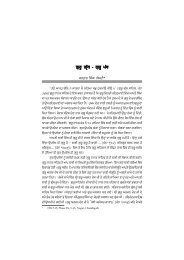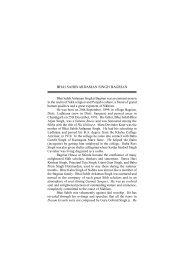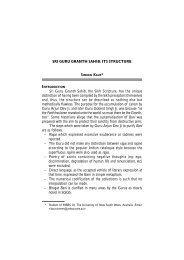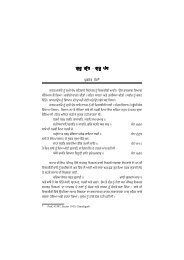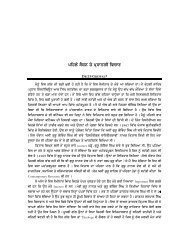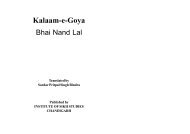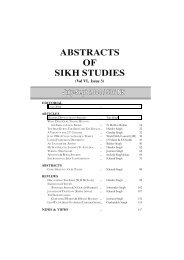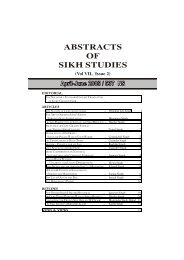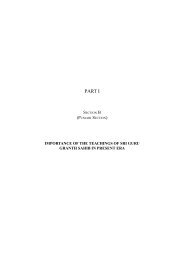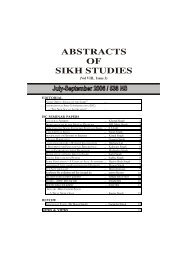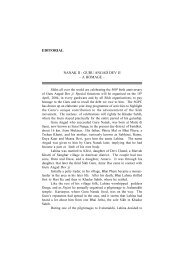You also want an ePaper? Increase the reach of your titles
YUMPU automatically turns print PDFs into web optimized ePapers that Google loves.
90ABSTRACTS OF SIKH STUDIES : JAN-MARCH <strong>2006</strong> / 537-38 NSSometimes, he used tonga for transportation to and fro work, butmore <strong>of</strong>ten he walked. Women in the neighbourhood would tell theirchildren to pay respect to him by touching his feet. He blessed themand always had pocketful <strong>of</strong> tid bits like dry fruit for such occasionsto give them lovingly.He left us a good collection <strong>of</strong> books. When we grew up, wevoraciously went through these with our young appetite for the writtenword. It is amazing to list the variety <strong>of</strong> subjects and authors. Extractfrom Guru Granth Sahib & its translation, discussion on banis, itsgrammar, <strong>Sikh</strong> history (Twarikh Guru Khalsa, Gubilas Patshai 6th &10th etc., Shamsher Khalsa, other biographies <strong>of</strong> Gurus including Puratan<strong>Jan</strong>am Sakhi, Bale wali <strong>Jan</strong>am Sakhi, books on Maharaja Ranjit Singh &his generals etc.). Books on poetry, magazines like Phulwari, PreetLari, Ruhani, Ohanodra, Fateh, Hans, etc. Books on other religionssuch as Hindu Mythology, Vedas, Puranas, Bible, Satyarath Prakash<strong>of</strong> Swami Dayanand - almost all in Punjabi Gurmukhi Script werealso available. The authors included persons like Bhai Kahn Singh <strong>of</strong>Nabha, Giani Dit Singh, Bhai Vir Singh, Pr<strong>of</strong> Puran Singh, Hira SinghDard, Prem Singh Hoti, Gurbaksh Singh Preet Lari, Akali Kaur Singh,Dhani Ram Chatrik, S S Charan Singh Shahid and many more. Thisshows his deep involvement in <strong>Sikh</strong> life and culture, and even otherreligious and diverse topics concerning spiritual and religious life.Another side <strong>of</strong> his personality was reflected in the design <strong>of</strong> hiskothi. The main building had a facade like a traditional <strong>Sikh</strong> palacewith chhajha and small gumtis. The approach to it was over what heused to call a “hilly bridge” a wide short road lined by brick wallsunder which water flowed serving the garden. In those days, this areawas served by canal water and a watercourse flowed through the suburb.The concept <strong>of</strong> garden was purely Indian. It meant variety <strong>of</strong> treesand plants with a water tank in the midst. The trees were so thick thatto us children it gave the impression <strong>of</strong> a forest. Birds like crows,parrots, sparrows, brown chattering birds, robins, shyamas, bulbulsetc., made their nests in the trees. The variety <strong>of</strong> trees and plants wasamazing. I have counted 35 to 40 types <strong>of</strong> fruit and flowering treesand creepers in the garden. Nobody can believe as at present, sincethese have disappeared; because <strong>of</strong> closure <strong>of</strong> the watercourse, besideslack <strong>of</strong> attention.



